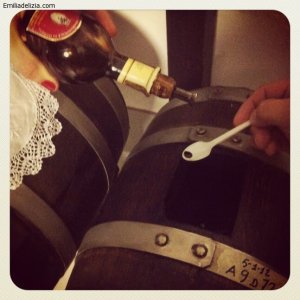When you plan your holidays in Italy we bet that you soon start thinking about delicious dishes to taste. If you then book a tour in Emilia Romagna, those obsessive images of tempting tortelli, Parma ham and chestnut desserts won’t leave you until you go and savor them!
Once arrived in the land of authentic Parmesan flavors, don’t stroll too much to find the perfect place. If you want to have a great meal, just let be guided by our accurate proposals. Emilia Delizia suggests two of finest places to dine in Parma with excellent dishes of the regional tradition, incredible desserts and superb wines: Parizzi and La Greppia.

Parizzi****
The outside of the restaurant is classy as much as the interior. Minimalist style and modern concept are the key features of the setting, as you will soon notice entering the door. A mix of tradition and innovation, you would say, reading their sophisticated menu.
At Parizzi you will be served anolini and tortelli d’erbetta (with fresh herbs) or filled with pumpkin (the famous tortelli di zucca) – stracotto (beef), and a mouthwatering “tutto castagne” dessert.
The modern side of the menu features Porcini and Fontina lovely arranged in a crunchy cone, risotto with snails and cress, pork barely smoked. For other culinary advice refer to Marco Parizzi, while for wine tasting ask to wife and sommelier Cristina who will gather some excellent bottles from their cellar. And of course you can ask for the tasteful PDO Parmesan cheese, Culatello and Parma ham.
The elegant atmosphere pervades the suites – perfect for a peaceful rest after a stroll in the city center of Parma – and the school kitchen – hosting exciting cooking lessons for those who wish to bring a little of Italian style in their own kitchen.
Parizzi restaurant is located in Strada Repubblica 71, in the multicolored facade houses street, where the bell tower of the remarkable San Sepolcro church stands out.
La Greppia****
A mix of modernity and regional flavors is what you will remember of this women-only run restaurant. Conscious of the strong culinary tradition, chef Paola Cavazzini is well determined to reinvent a menu with signature dishes.
Seasonal food seems to be the secret for antipasti, primi and secondi marked by a strong savor: artichokes covered with a soft ham sauce, handmade pasta stuffed with pumpkin or chestnuts, rice Venere enriched with black truffles, salted codfish with tomatoes and potatoes, veal savored with ginger. Finally, the top desserts pumpkin pudding and kaki ice cream are a must!
At La Greppia, you will dine in a cozy atmosphere, under soft lights and wooden roof. You will happily notice wooden shelves and tables where fine wines and baskets of handmade pasta are exposed, perfectly arranged tables with elegant tablecloths, impeccable cleanliness and service.
La Greppia restaurant is located in Via Garibaldi 39. You can reach the restaurant after a visit to the Sanctuary of Santa Maria della Steccata and Teatro Regio, two of the greatest tourist attractions in Parma.







![IMG_2734[1]](https://i0.wp.com/www.emiliadelizia.com/wp-content/uploads/2013/01/IMG_27341-e1357380178784.jpg?resize=448%2C600&ssl=1)







